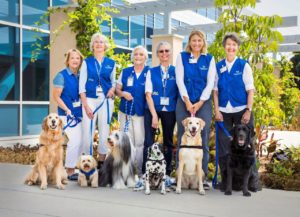 • Razzle Dazzle some cat stole your photo so please send it to us again.
• Razzle Dazzle some cat stole your photo so please send it to us again.

• Therapy dogs Lola, Herbie, Livi, Posey, Molli and Jock currently visit the patients and staff at CMHS twice a month. They meet at 11am in the lobby and visit patients who would like to see the dogs on the sixth floor and, if there are patients in Pediatrics on 7, they visit with them. They visit in teams of two. It brings such joy to patients, staff, families and visitors. Much more so than a human.
They represent the Dr Peter Gall Therapy Dog Program

•On October 26, five new Search Teams were partnered at the National Training Center as the training team officially handed the Search Dogs’ leashes over to their new firefighter-handlers. With nearly 100 friends, family, SDF staff and volunteers in attendance, they welcomed the newest teams to the SDF family: Mike Devine & Sonny and Ryan Greenup & Koda (both with Los Angeles County Fire Department/California Task Force 2), Michael Bruce & Cooper, Imelda Cordova & Knox, both Orange County Fire Authority, and Wade Haller & Dallas of Long Beach Fire Department (all with California Task Force 5). Congratulations to the new teams and a big thank you to everyone who helped these dogs and handlers achieve this first major milestone in their careers together!
Cats and dogs may occupy similar places in people’s hearts, but when it comes to the two species’ hearts—and heart disease—there are a lot of differences. Dr. Ryan Fries, a veterinary cardiologist at the University of Illinois Veterinary Teaching Hospital in Urbana, explains some of these differences and how he is working to improve the prospects for afflicted cats.
Chronic valvular disease is the most common type of heart disease in dogs. In it, the valves degenerate and become misshapen, causing the valves to leak. Occasionally cats are born with heart valve disease, but the development of degenerative valvular disease over time, as it occurs in dogs, is not seen in cats.
Hypertrophic cardiomyopathy, on the other hand, accounts for 80 percent of cases of heart disease in domestic cats but is rare in dogs. In this disease, one or several areas of the walls of the heart become abnormally thickened.
“Certain breeds, such as Maine Coon and Ragdoll cats, are genetically predisposed to developing hypertrophic cardiomyopathy, but any cat can develop this disease,” says Dr. Fries.
Genetic tests are available for predisposed breeds to identify cats that carry the genetic mutation for hypertrophic cardiomyopathy. Cats carrying this mutation should not be bred.
Restrictive cardiomyopathy and dilated cardiomyopathy are rarely seen in cats.
“Dilated cardiomyopathy was actually very common in cats before the 1980s. Then, veterinarians discovered that dilated cardiomyopathy was linked to a taurine deficiency in commercial cat food. Now that taurine is appropriately added to cat food, this problem is quite rare in cats,” explains Dr. Fries.
Not only do the types of heart disease cats and dogs acquire differ, so do the clinical manifestations of heart disease. “Dogs almost always have an audible murmur, meaning it can be detected with a stethoscope by a veterinarian. This is not true in cats,” he says.
Radiographs (X-rays) of the chest are also commonly used to diagnose heart disease in dogs but are not as useful in cats. “We need an echocardiogram to definitively diagnose heart disease in a cat,” says Dr. Fries.
Symptoms of heart disease in cats can be subtle and non-specific. Owners may notice that their feline friends are hiding more, are less interested in the food, or generally more lethargic. Cats are masters at hiding sickness, so any changes in behavior should tip off an owner that something isn’t quite right. Cats may also show signs of respiratory distress, such as labored breathing, panting, and open-mouth breathing.
Because of changes in blood flow and enlargement of the left atrium, cats with heart disease are at increased risk for blood clot formation within the heart. Pieces of these clots may break off, being swept by the bloodstream to locations distant from the heart (thromboembolism).
The most common site for thromboembolism in cats is the back legs (saddle thrombus). This leads to acute weakness/paralysis and pain in these limbs. Cats showing signs like this should be taken to a veterinarian immediately.
“Bringing your cat for annual examinations and talking to your veterinarian when you notice any changes in your cat’s behavior are the best ways to catch heart disease at earlier stages,” recommends Dr. Fries.
“There are basically two stages of heart disease in cats, and each hold a different prognosis. In the first stage, the cat has confirmed heart disease and is at risk of developing clinical problems,” says Dr. Fries. “In the later stage, the cat has heart disease as well as clinical problems, such as heart failure or thromboembolism. An echocardiogram with a veterinary cardiologist can determine which stage a cat is in.”
“Heart health is just as vital to cats as it is to dogs, but heart disease is much more difficult to detect in cats. Regular visits to your veterinarian can help protect your cat’s heart and overall health,” says Dr. Fries.
